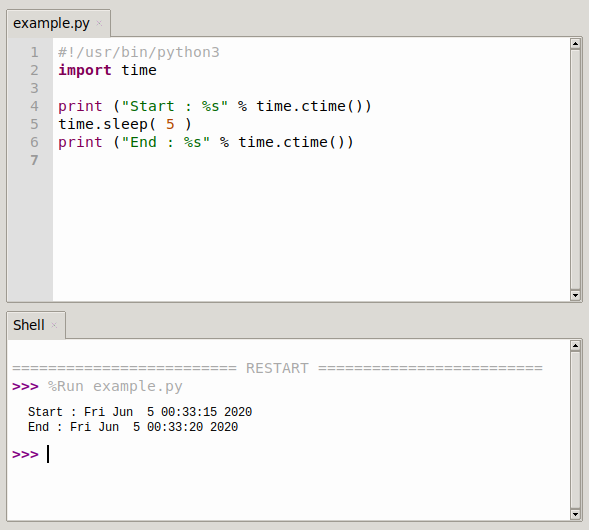Antwort How do you wait 3 seconds in Python? Weitere Antworten – How do I make Python wait 3 seconds
Method 1: Using time. sleep() function
- Import the time module.
- For adding time delay during execution we use the sleep() function between the two statements between which we want the delay. In the sleep() function passing the parameter as an integer or float value.
- Run the program.
- Notice the delay in the execution time.
To pause or delay execution in Python, you can use the sleep() function from Python's time module: time. sleep(5) . This function makes Python wait for a specified number of seconds.The code is using Event(). wait(5). The number 5 is the number of seconds the code will delay to go to the next line that calls the function display(). Once the 5 seconds are done, the function display() will be called, and the message will be printed inside in the terminal.
How do you delay 1 second in Python : How to use the Sleep function to introduce a 1-second delay in your code execution:
- import time.
- print("Start")
- time. sleep(1)
- print("End")
How do I make Python wait 10 seconds
Adding a Python sleep() Call With time.sleep()
The time module has a function sleep() that you can use to suspend execution of the calling thread for however many seconds you specify. If you run this code in your console, then you should experience a delay before you can enter a new statement in the REPL.
How to do wait () in Python : If you've got a Python program and you want to make it wait, you can use a simple function like this one: time. sleep(x) where x is the number of seconds that you want your program to wait.
You might need to wait for another function to complete, for a file to upload, or simply to make the user experience smoother. If you've got a Python program and you want to make it wait, you can use a simple function like this one: time. sleep(x) where x is the number of seconds that you want your program to wait.
print("Wait until 2 seconds.") # Output: Wait until 2 seconds.
- Python sleep() Syntax. time.sleep(seconds)
- sleep() Parameters. The method takes a single parameter:
- sleep() Return Value. The method does not return any value.
- Example: sleep() Method.
- Create a Digital Clock in Python.
How do you stop 2 seconds in Python
import time print("Executing the first line of code.") time. sleep(2) print("Executing the second line of code after a 2-second delay.") This example introduces a 2-second delay before executing the second line, useful for creating pauses between actions or simulating real-world scenarios.The sleep() function
To use the `sleep()` function, you need to import the `time` module first. Here's an example: import time print("Starting…") time. sleep(2) # add a 2-second delay print("…The Solution. from time import sleep print("Waiting 1 minute…") sleep(60) print("1 minute has passed.")
The Solution. from time import sleep print("Waiting 1 minute…") sleep(60) print("1 minute has passed.")
How do you pause and wait for input in Python : In Python, the input() function can be used to pause your program and wait for user input. Here's a simple example: for i in range(10): print(i) input("Press Enter to continue…") In this code, the for loop will print a number, then pause and wait for the user to press Enter before continuing.
How do you delay 60 seconds in Python : If you've got a Python program and you want to make it wait, you can use a simple function like this one: time. sleep(x) where x is the number of seconds that you want your program to wait.
Is sleep () in seconds
The sleep() function in python's time module is used to suspend the execution of a program for the given number of seconds. This means that the program is paused for the given time and after that time has passed, the program gets executed automatically.
In Python, the time() function returns the number of seconds passed since epoch (the point where time begins). For the Unix system, January 1, 1970, 00:00:00 at UTC is epoch. In the above example, we have used the time. time() function to get the current time in seconds since the epoch, and then printed the result.This is done by using the timedelta() method of the datetime module, which allows you to add or subtract a specific amount of time to a datetime object. In this case, the timedelta() method is called with the arguments 0 (for zero days) and 5 (for five seconds).
How to use timer in Python : Python Timer Usage Guide
- import time start_time = time.
- import time start_time = time.
- import timeit # Let's time the execution of a list comprehension start_time = timeit.
- from datetime import datetime start_time = datetime.
- import pytest # Function to test def my_function(): time.
- import timeit start_time = timeit.







